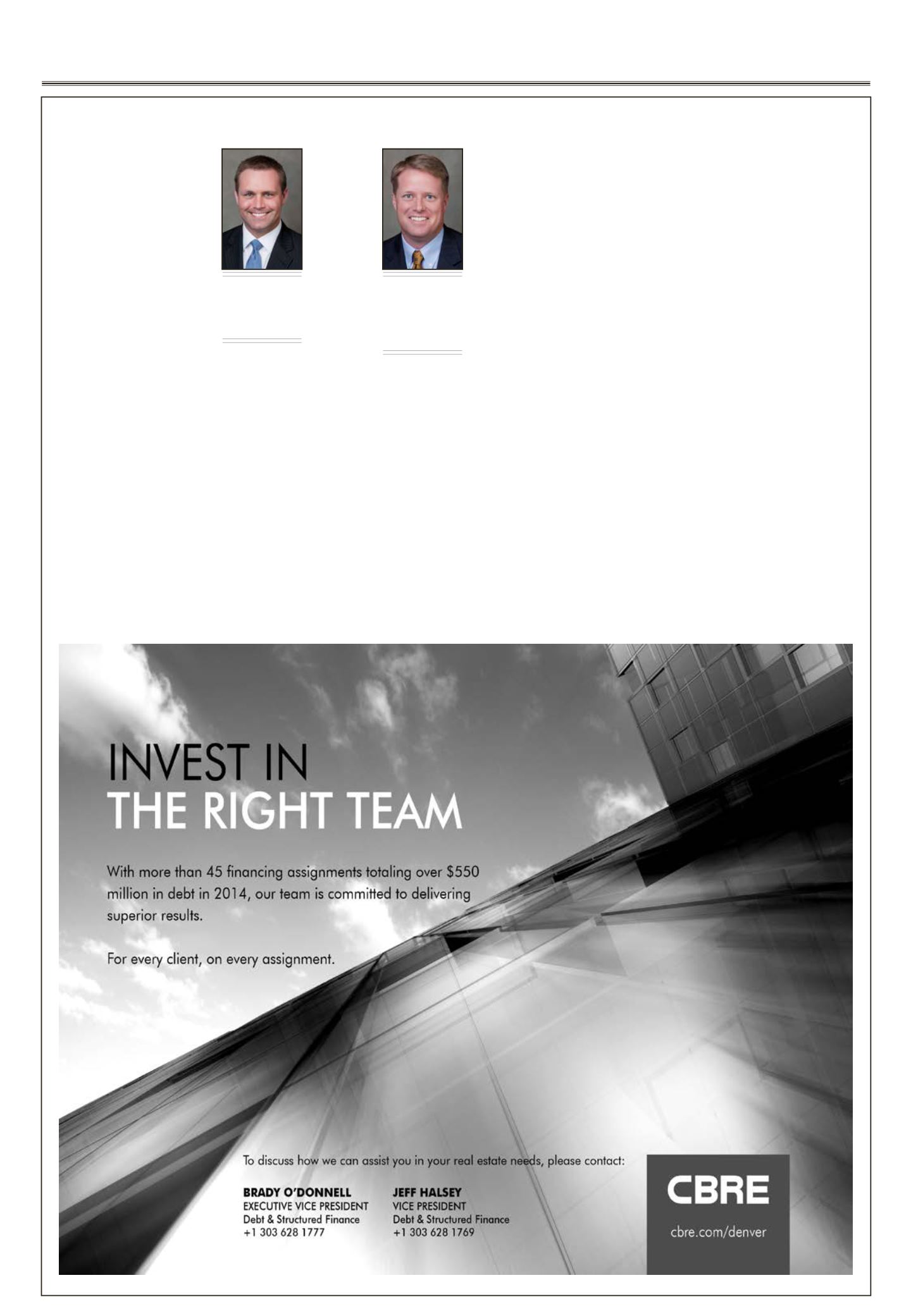

February 18-March 3, 2015 —
COLORADO REAL ESTATE JOURNAL
— Page 25
I
f our current environ-
ment is “the new nor-
mal,” then for the fore-
seeable future, it is locked
into a state of volatility and
inconsistency. In a way, it
parallels a principle of chaos
theory: a butterfly flaps its
wings in the United States,
which results in a hurricane
in China. However in this
case, the butterfly can be
one of many things; ISIS,
Greece, the Ebola Virus,
OPEC, Russia, the Federal
Reserve, etc. The consis-
tent theme is that each of
the above has impacted
our markets throughout
the last few years. In our
forecast last year we highly
anticipated, along with most
every market analyst, that
going in to 2015 the 10-year
Treasury would be well
north of 3 percent. On the
contrary, last month wit-
nessed yields as low as 1.65
percent, keeping the lending
environment quite favorable
for commercial real estate
investors.
Just how long will this
last? The message from the
2015 Mortgage Bankers
Association Commercial
Real Estate Finance confer-
ence held recently in San
Diego
was over-
whelm-
ingly posi-
tive. As an
asset class,
real estate
continues
to be a top
performer
with little
to no ero-
sion in
market
fundamen-
tals on the
horizon.
Vacancy rates are low across
the country, rents are rising,
and outside of multifam-
ily, there does not seem to
be fear of an oversupply
issue in the near term, since
development activity is still
below historical norms. In
spite of the volatility the
Federal Reserve is expected
to raise rates sometime this
summer, driving investors
to move quickly on acquisi-
tions and refinancings while
they still can.
CBRE’s Debt &
Structured Finance group
had a record year with
$33.2 billion in originations
nationwide, up from $25.7
billion in 2013. Again, mul-
tifamily led
all asset
classes
with an
extremely
competitive
appetite
from agen-
cy lenders
(Fannie
Mae,
Freddie
Mac), as
well as life
insurance
companies,
banks and
commercial
mortgage-backed securities
lenders. Freddie Mac and
Fannie Mae are offering
long-term options with a
LIBOR-based floating-rate
component, as well as for-
ward index locks to mitigate
the risk of rising interest
rates. While cap rates con-
tinue to compress in this
space, effective interest
rates in the 3.25 to 3.5 per-
cent range allow for positive
leverage right out of the
gates.
Life insurance companies,
typically the most conser-
vative lenders in terms of
underwriting, have set high-
er allocations once again
for 2015 and are enjoying a
competitive advantage with
their ability to lock a for-
ward interest rate up to 18
months in advance in some
cases. Interest rate floors in
low- to mid-3 percent range
are achievable in the cur-
rent rate environment and
a number of investors with
looming maturities in the
next two years are expected
to hedge by entering for-
ward rate locks. The sweet
spot for life companies con-
tinues to be in the 55 to 65
percent loan-to-value range
with interest-only periods
available for lower-leveraged
deals.
The commercial mortgage-
backed securities space is
the most competitive lend-
ing environment with over
40 different originators in
the market. Over $90 billion
in securitized loans were
originated in 2014 with out-
puts in 2015 expected to be
well north of $100 million.
Recently, CMBS origina-
tors have tried to separate
themselves from the pack by
stripping away onerous cash
management structures and
offering lengthier interest
only periods. The new met-
ric in CMBS 2.0, the debt
yield, has also compressed,
which is the most unnerv-
ing sign that underwriting
standards are softening
back to pre-2008 levels.
Nonetheless, demand for
CMBS paper ebbs and flows
with market events. For
example, CMBS originators
have responded to the dip
in oil prices by putting new
issuances on hold in energy-
driven locations.
Over the next three years,
we will see a steady stream
of sale and refinance activ-
ity with $325 billion in
outstanding debt maturities
due in 2015, $368 billion
in 2016 and $423 billion
in 2017. A rising interest
rate environment will likely
have an adverse impact on
cap rates and valuations in
the commercial real estate
arena. But as long as the
rise is steady, there is no
reason to believe that it will
completely stall the market.
There may be a few good
years left in this current
run and our prediction is
that 2015 will be fast paced
and frothy, albeit with a few
bumps in the road here and
there.
Jeff Halsey
Vice president,
Debt & Structured
Finance, CBRE
Capital Markets,
Denver
Brady
O’Donnell
Executive vice
president, Debt &
Structured Finance,
CBRE Capital
Markets, Denver
Navigating the capital markets in “the new normal”Finance
















